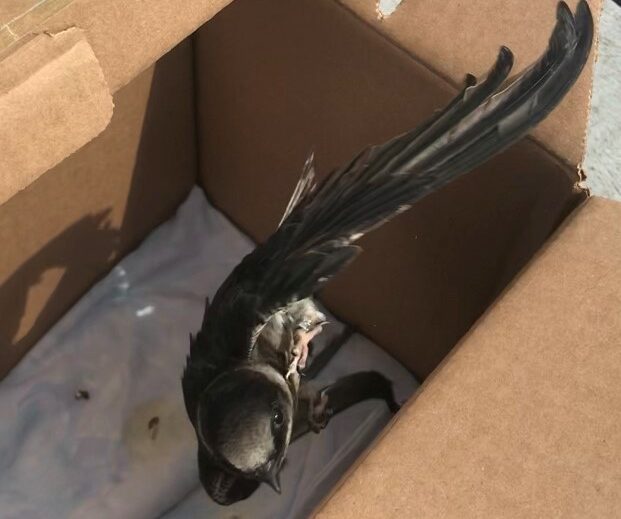More than 9,760 species of wild animals and plants are critically endangered, while over 40,000 are endangered or vulnerable. This means big trouble worldwide, with so many species potentially threatened with extinction. World Wildlife Day 2024 is focused on recovering key species for ecosystem restoration. To reverse the fate of the most critically endangered species, supporting the restoration of their habitats and ecosystems is crucial.
Learn more about some of the most critically endangered species in B.C., and spread the word.
Purple martin
Purple martins are the largest swallow in North America. They are commonly known for their unique colouring, agility and speed – topping 40 miles per hour! Due to habitat loss, development and competition, the western purple martin population in B.C. was down to only 10 breeding pairs by the 1980s. Thanks to an amazing volunteer nestbox program, the purple martin population has gradually increased to roughly 1,300 pairs. They’re not out of the woods yet, but this remarkable recovery is thanks to the efforts of many collaborators, funders and volunteers.
Although a less common visitor, Wild ARC usually expects to care for a few purple martins each year. Patients like this purple martin remind us what is at stake.

Vancouver Island marmot
The Vancouver Island marmot is found in only a few small mountainous pockets on Vancouver Island. They’re one of only a few mammals to occur in Canada and nowhere else. Vancouver Island marmots have dark, chocolate-brown fur, with white noses, bellies and foreheads. They hibernate in family groups over the long winter, and are active only a few hours a day – lounging on rocks and watching for predators. If you’re lucky enough to spot them, you can expect to enjoy watching them touch noses in greeting, play fight or hear any of their five distinct whistles or trills.
Although resilient, these marmots are critically endangered – with fewer than 30 in the wild in 2004. Their decline is still a mystery, but is suggested to be due to a change in predator-prey dynamics because of ongoing landscape changes. Thanks to significant conservation recovery efforts, their population has increased to over 300 individuals in 2023.

Spotted owls
The northern spotted owl is one of Canada’s most endangered species – fewer than a dozen individuals still live in B.C. These medium-sized owls rely on old-growth forests to roost, nest and hunt. Unfortunately, spotted owls and old-growth forests are both in trouble. Their decline is due to habitat loss from ongoing logging and human disturbances.
Spotted owls are frequently confused with barred owls – a much more abundant close relative. Barred owls have grey plumage, with vertical brown streaks on their chest, and no spots. Spotted owls are more brown, with white oval spots on their body feathers and horizontal white bars on their chest. Barred owls are often blamed for the decline of spotted owls because they can live in both deciduous and coniferous forest. However, habitat loss is the biggest threat to spotted owls.
Caribou
Woodland caribou are an iconic species in the mountainous forests of B.C. They graze mainly on lichen – a slow-growing plant – found in old-growth forests. Their survival is intimately linked to the survival of old-growth habitat, but this is at risk due to logging and other human activities like mining, oil and gas, renewable energy and road building. Human disturbances cause them to leave their preferred habitat, and move in to less desirable areas.
Wolves are also blamed for the decline of caribou because roads and seismic lines for oil and gas make it easier for them to move through caribou habitat. However, it is possible to modify these disturbances to reduce encounters between caribou and wolves, without killing wolves. Damage and disruption to habitat is the key factor in caribou decline.

Little brown bats
The little brown bat is one of the most familiar species of bats in B.C., and the most common…for now. They are still considered endangered because a fungal disease called White-Nose Syndrome is devastating bat populations across North America. The fungus grows on the nose and bodies of infected bats during hibernation. The fungus causes them to wake during their hibernation, using valuable energy at a time they should be conserving it. Sadly, bats usually die of starvation after they are infected.
White-Nose Syndrome has not been observed in B.C. yet, but the fungus that causes White-Nose Syndrome was detected in the Grand Forks area in 2023. Scientists are racing to find a cure or preventative treatment before these animals are all lost. Losing an animal that can eat over 1,000 insects an hour means big trouble for us – bats are important pollinators and natural pest control agents in agriculture.
Wild ARC regularly treats a handful of these patients each year. They come into care for all sorts of reasons – in summer when they are caught by a cat, hit by a car, or trapped where they can’t escape, and in winter if their hibernation is disturbed by construction or other human interference.

Today, on World Wildlife Day, let’s remember that we all have a shared responsibility to coexist with and ensure the welfare of wild animals. Wildlife rehabilitation contributes to the conservation and protection of these and other wild animals every day. Wild ARC is the only wild animal rehabilitation centre of its kind on southern Vancouver Island and we’re here to help our local wildlife when they run into trouble. We depend on the support of compassionate animal-lovers like you to care for so many injured, orphaned or sick wild animals. Your support today is vital to ensure wild animals receive the specialized care they need for a second chance at life in the wild.
DONATE
